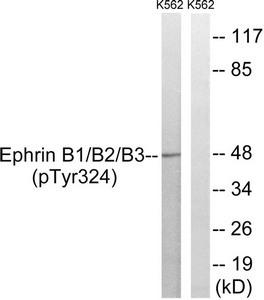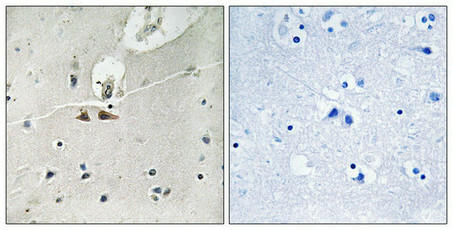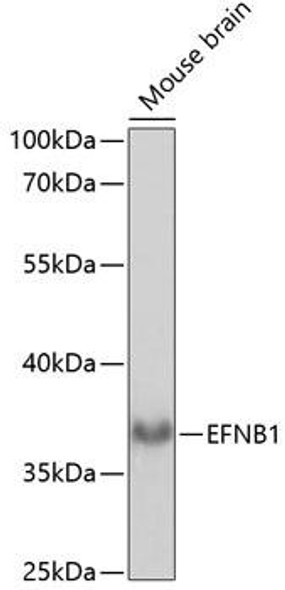Description
Phospho-EFNB1/EFNB2/EFNB3 (Tyr324) Antibody (PACO24401)
The Phospho-EFNB1/EFNB2/EFNB3 (Tyr324) Antibody (PAC024401) is a valuable tool for researchers studying the phosphorylation of Ephrin-B1, Ephrin-B2, and Ephrin-B3 proteins at the tyrosine 324 residue. This antibody, generated in rabbits, exhibits high specificity and sensitivity in detecting phosphorylated forms of these proteins in human samples.Phosphorylation of EFNB1, EFNB2, and EFNB3 at Tyr324 plays a crucial role in regulating cell signaling pathways involved in cell adhesion, migration, and axon guidance. By targeting this specific phosphorylation site, researchers can gain insights into the functional implications of these proteins in various cellular processes.
The Phospho-EFNB1/EFNB2/EFNB3 (Tyr324) Antibody is suitable for use in Western blot applications, enabling the detection and quantification of phosphorylated Ephrin-B proteins. Its versatility in detecting phosphorylation events in different cell types makes it an essential tool for studies in cell biology, neuroscience, and cancer research. By understanding the role of EFNB1, EFNB2, and EFNB3 phosphorylation, researchers can uncover potential therapeutic targets for the treatment of neurodevelopmental disorders, cancer, and other diseases.
| Antibody Name: | Phospho-EFNB1/EFNB2/EFNB3 (Tyr324) Antibody (PACO24401) |
| Antibody SKU: | PACO24401 |
| Size: | 100ul |
| Host Species: | Rabbit |
| Tested Applications: | ELISA, WB, IHC |
| Recommended Dilutions: | ELISA:1:2000-1:10000, WB:1:500-1:1000, IHC:1:50-1:100 |
| Species Reactivity: | Human, Mouse, Rat |
| Immunogen: | Peptide sequence around phosphorylation site of tyrosine 324 (G-D-Y(p)-G-H) derived from Human Ephrin B1/B2/B3 . |
| Form: | Liquid |
| Storage Buffer: | Rabbit IgG in phosphate buffered saline (without Mg2+ and Ca2+), pH 7.4, 150mM NaCl, 0.02% sodium azide and 50% glycerol. |
| Purification Method: | Antibodies were produced by immunizing rabbits with synthetic phosphopeptide and KLH conjugates. Antibodies were purified by affinity-chromatography using epitope-specific phosphopeptide. Non-phospho specific antibodies were removed by chromatogramphy using non-phosphopeptide. |
| Clonality: | Polyclonal |
| Isotype: | IgG |
| Conjugate: | Non-conjugated |
 | Western blot analysis of extracts from K562 cells treated with serum using Ephrin B1/B2/B3 (Phospho-Tyr324) Antibody.The lane on the right is treated with the antigen-specific peptide. |
 | Immunohistochemical analysis of paraffin-embedded human brain tissue using Ephrin B1/B2/B3 (Phospho-Tyr324) antibody (left)or the same antibody preincubated with blocking peptide (right). |
| Background: | This gene encodes a member of the ephrin family. The encoded protein is a type I membrane protein and a ligand of Eph-related receptor tyrosine kinases. It may play a role in cell adhesion and function in the development or maintenance of the nervous system. |
| Synonyms: | EPL2; CEL5-L; EFL-3; EFNB1; ELK-L |
| UniProt Protein Function: | EFNB1: a type I membrane protein of the ephrin family. A ligand of Eph-related receptor tyrosine kinases EphB1 and EphA1. Ephrins and ephrin receptors mediate numerous developmental processes, particularly in the nervous system. Ephrin-B1 may play a role in cell adhesion and functions in the development or maintenance of the nervous system. Binding to its receptor induces the collapse of commissural axons/growth cones in vitro. Induced by TNF-alpha. Expressed in brain, heart, placenta, lung, liver, skeletal muscle, kidney, and pancreas. |
| UniProt Protein Details: | Protein type:Membrane protein, integral; Ligand, receptor tyrosine kinase Chromosomal Location of Human Ortholog: Xq12 Cellular Component: integral to plasma membrane; cytoplasm; plasma membrane; synapse; nucleus; lipid raft Molecular Function:protein binding; ephrin receptor binding Biological Process: axon guidance; cell-cell signaling; ephrin receptor signaling pathway; positive regulation of T cell proliferation; cell adhesion; embryonic pattern specification; neural crest cell migration Disease: Craniofrontonasal Syndrome |
| NCBI Summary: | The protein encoded by this gene is a type I membrane protein and a ligand of Eph-related receptor tyrosine kinases. It may play a role in cell adhesion and function in the development or maintenance of the nervous system. [provided by RefSeq, Jul 2008] |
| UniProt Code: | P98172 |
| NCBI GenInfo Identifier: | 1706668 |
| NCBI Gene ID: | 1947 |
| NCBI Accession: | P98172.1 |
| UniProt Secondary Accession: | P98172,D3DVU0, |
| UniProt Related Accession: | P98172 |
| Molecular Weight: | 346 |
| NCBI Full Name: | Ephrin-B1 |
| NCBI Synonym Full Names: | ephrin-B1 |
| NCBI Official Symbol: | EFNB1 |
| NCBI Official Synonym Symbols: | CFND; CFNS; EFB1; EFL3; EPLG2; Elk-L; LERK2 |
| NCBI Protein Information: | ephrin-B1; EFL-3; LERK-2; ELK ligand; ligand of eph-related kinase 2; eph-related receptor tyrosine kinase ligand 2 |
| UniProt Protein Name: | Ephrin-B1 |
| UniProt Synonym Protein Names: | EFL-3; ELK ligand; ELK-L; EPH-related receptor tyrosine kinase ligand 2; LERK-2 |
| Protein Family: | Ephrin |
| UniProt Gene Name: | EFNB1 |
| UniProt Entry Name: | EFNB1_HUMAN |














